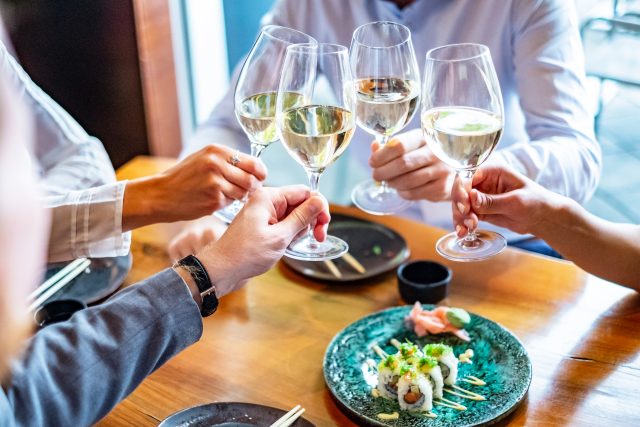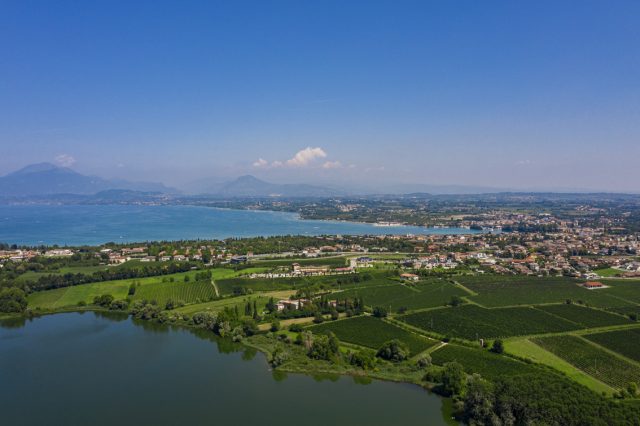This website uses cookies so that we can provide you with the best user experience possible. Cookie information is stored in your browser and performs functions such as recognising you when you return to our website and helping our team to understand which sections of the website you find most interesting and useful.
Why you should drink Lugana wines with sushi
Consorzio Tutela Lugana DOC is bucking tradition by suggesting that its white wines should be paired with East Asian dishes, and not just with Italian food.

Speaking to db at Vinitaly, Edoardo Peduto, who was announced as new director for the Northern Italian appellation’s consorzio this March, explained the current state of Lugana DOC’s international standing: “In 2022, 28 million bottles were produced, and 70% of production goes abroad. Germany is the biggest market, followed by the UK and US, and there are also some exports to Japan.”
“The ambition is to improve our foreign markets, and so we are going to be doing promotional activities in the UK and US,” Peduto shared.
“The key ambition for us is to identify Lugana with Lake Garda. In my opinion, this is the driving force for us – when people abroad drink Lugana, they think of Lake Garda,” he suggested.
Indeed, Lake Garda is a major part of what gives Lugana its “unique” terroir, according to Peduto. The region’s celebrated white grape variety, Turbiana (formerly known as Trebbiano di Lugana), is also a key asset due to its versatility when it comes wine styles. While up to 10% of other to grape varieties is permitted to be blended into Lugana DOC wines, a growing number favour the single varietal approach.

There are five categories of Lugana wine. The ‘basic’ expression, constituting almost 90% of the PDO’s production, is pale straw in colour and has floral aromas with an almond note. Lugana Superiore, a category introduced in 1998, must be aged or refined for at least one year after harvest, and is characterised by a tinge of gold in the colour, and aromas of wild herbs and ripe apple. Lugana Riserva is aged for a minimum of 24 months (six months in bottle), typically has greater structure and a subtle balsamic note.
There is also a sparkling variant, Lugana Spumante, and a sweet one, Vendemmia Tardiva (for which the harvest is delayed until late October). At present, just three producers produce the late harvest style of Lugana, and sparkling wine only makes up about 2% of production.
“The versatility of the wine is amazing,” Peduto explained. “It’s great as an aperitivo drunk in the sun with friends, but it’s also amazing as a pairing, and not just with Italian food.”
Peduto argued: “The pairing of Lugana with Asian food is incredible. Of course, when you think of white wine, you think of pairing with fish, but in my opinion it’s also great with meat.”
In this writer’s opinion, Lugana Superiore would make a good pairing with an aromatically intense Thai green curry, filling the pairing role that might otherwise be taken by something like a Riesling (it also has similarly high acidity, which will cut through the fattiness of the coconut milk).
The ‘basic’ Lugana, meanwhile, would be a particularly good accompaniment to sushi or sashimi, due to its fresh acidity and delicate citrus aromas working well with the slight oiliness of raw tuna, salmon and mackerel.
Furthermore, the aromatic qualities of Turbiana could make its wines a good foil to balance the pungent, nasal heat of wasabi.
Italy alone has an estimated 26,000 sushi restaurants, and given the enormous popularity of East Asian cuisines elsewhere in the world, including in Lugana DOC’s key markets, this could form a key promotional thrust for the appellation both domestically and abroad.
“When I talk about versatility,” Peduto remarked, “I mean that Lugana should go with everything!”
Lugana isn’t the only region around Lake Garda to suggest enjoying its white wines with Asian-inspired dishes. The Soave Consortium has had “a lot of success” in pairing Classico, Superiore and Recioto expressions with different types of poke the Hawaiian dish of diced raw fish on top of rice with various accompaniments.

